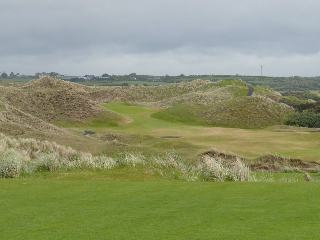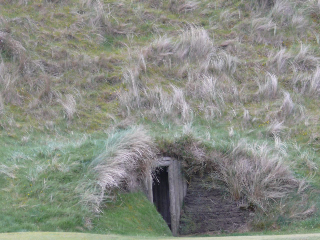Featured Golf News
To Ireland and Back - Day Seven
So the trip to Ireland ended on what I consider the finest links course in the world, Royal County Down. You weave quietly through the dunes, catch a glimpse here and there of the Irish Sea and finally, arriving at the par-3 fourth tee, contemplate a 200-yard shot into the wind over a blanket of yellow gorse.

One of the Green Settings at Portstewart.
Maybe it isn't standing at the edge of the Grand Canyon or in front of the Mona Lisa. Maybe it is better. I announced to my playing partners that the front nine at Royal County Down was simply the best nine holes of golf on the planet.
Lost in their own thoughts and the roar of the winds and the sea, I'm not sure they even heard what I said. No cares.
This was a personal pilgrimage for me, returning to Northern Ireland for the first time in 20 years only to find Royal County Down better than I had remembered it.
The greens were better, the only weak hole on the course - the 16th - had been altered, and there was a new pro shop and restaurant for visitors, not simply the "visitors changing room" hole-in-the-wall that was there before.
But what was best was the lack of change. Even though the green fees had gone from $35 to $280, there was still no advancing Americanization, no bag drops, no carts, no cart paths, no yardage markers, no beverage cart girls.
At the new Jack Nicklaus-designed Killeen Castle near Dublin - site of this September's Solheim Cup between American and European women - there was a long driving range, a short range, and a Dave Pelz school of instruction. There were also carts, or buggies, as they call them over here.
At Royal Portush there was a small Astroturf mat back of the starter's shack for you to take practice swings. Gents, no practice swings on the tee, please. At Royal County Down there were a couple of nets behind a tall hedge to prepare for your round.
Maybe Bandon Dunes is somewhere in the middle with its one-acre putting green, its 22-acre driving range. Pat Ruddy has a practice field, as he calls it, as his European Club course. Maybe we are improving as a species, maybe not.
We continue to ask the question: does the emergence of real links golf on the West Coast, at Bandon and at Chambers Bay, whet or satiate the need to play in stiff winds on firm surfaces, surely a different kind of golf?
My guess is it does both, because as good as the Bandon courses are - and they rank with the best in Ireland - the experience here is different.
The Guinness tastes better. The hospitality is more intriguing. There is also history. Where else do you have a first tee against the backdrop of an 11th Century castle and where the first shot must carry water and rocks the way you do at Ardglass?
If you're looking for comparisons, Pacific Dunes would fit in lovely - as they say around here - into the Irish landscape. As far as I'm concerned, Bandon Dunes and Old Macdonald, as well as Chambers Bay, are more like Scotland than Ireland.
Certainly the greens at Bandon Dunes and Chambers Bay are more difficult than the greens on the best courses in Ireland. More like St. Andrews. None of this means the greens are easy to figure in Ireland. The surrounds are often slippery and fatal, sending shots sliding into bunkers you didn't even know existed.

Looking Across the Links at Portstewart.
The beauty of the Bandon Dunes resort is that owner Mike Keiser didn't compromise the resort to meet American expectations. The fundamental decision to eliminate carts and cart paths freed his courses to follow hill and dale, using - not altering - the natural landscape. The sandy soils and mild climates were perfect for fescue grasses and firm, fast fairways.
Keiser also respected the land and the game enough to keep the clubhouse in the background, to let the golf holes have the prime real estate, not the spa or convention center. Indeed, there are no spas or convention centers at his place.
But as good as the American courses are, they don't have the history of the courses of the British Isles, or the characters, the specter of Old Tom Morris and Christy O'Connor, or the character of Ruddy.
As far as accommodations for golf in Ireland, they are as varied and wonderful as the courses, from B&Bs to grand hotels, from the quaint Bushmills Inn near the distillery and the courses at Portrush and Portstewart, to the monumental Slieve Donard on the edge of County Down, to the Grand Hotel at Malahide next to Portmarnock.
We drove ourselves in a mini-van rented at the Dublin airport. You can plan your trip on the Internet if you want, or let someone else do the planning and the driving. The options are there.
As we walked the fairways of the great Northern Ireland Courses - Portrush and County Down - we wondered why Portrush had hosted only one British Open Championship and Royal County Down none.
Was it politics? Was it the four or five completely blind tee shots at County Down? Surely those courses are better than some that are on the current Open Championship rotation.
The Irish courses are more likely to produce hidden pockets of grief and exacerbate a poor shot than the Scottish or American links courses. The tour players like to see everything in front of them, something that doesn't happen at either County Down or Portrush. They are completely what they are, sometimes unfair but always adventuresome.
In Ireland, especially at Royal Portrush, the emphasis is put on controlling shots. The rough is unforthcoming, the bunkers brutal. Consider them, in most cases, to be water hazards except you get your ball back.
I found one bunker at County Down where my ball was under a 10-foot ledge and amongst seashells. I was lucky to get out the way I came in.
In both Ireland and at Bandon Dunes, 18-hole scores are conveniently forgotten in the talk of wind or the rain, and great holes. Par often doesn't matter. We played County Down in 30-mile-per-hour winds, and I was left to remember a par on the first hole and an even better bogey on the last as my greatest accomplishments.
The Irish courses aren't set up to accommodate everyone. At Royal County Down, the third set of tees - the gold tees - were 6,700 yards, with the ladies' reds at 6,200 yards.
As far as value, in peak season the great courses in Ireland are nearly $300 a round, while the Bandon Dunes courses are between $200 and $250. Chambers Bay is a relative bargain at $150-$175.
You would have expected that green fees on the great courses would have tumbled with the Irish economy, but they haven't. It appears that Ireland's elite courses would rather have fewer visitors at a top dollar, than more at a reasonable rate. Remember, they are first private clubs and, second, tourist destinations.
The reality is that America isn't Ireland, that it doesn't have the history or the hospitality. There will always be that need to wander the "Auld Sod," to return to golf's beginnings. And now to compare them to our own links courses.

Where to Get out of the Weather in Ireland.
So we'd done nine courses in seven memorable days. While Royal County Down was the best we played, I most enjoyed the almost sensuous links at Baltray in County Louth, an away-from-it-all place down by the Irish Sea where the golf was pure and the course naturally deceiving, and, yes, rewarding.
Ardglass, where the first tee is against the castle backdrop, was the hidden gem, and the Island Club near the Dublin airport a funky delight but like Ardglass not short on classic holes either.
We were never more than two hours from Dublin. We enjoyed pubs in the city - and the countryside; we had fish and chips one day and venison the next; we visited Ireland's Gettysburg, the Battle of the Boyne and looked down on the Giants Causeway in Northern Ireland.
We saw the past and the future of Irish golf, able to play the new Killeen Castle layout that will host September's Solheim Cup between the U.S. and Europe.
And to end the trip at Royal County Down.
For more information, visit www.discoverireland.com.
Blaine Newnham has covered golf for 50 years. He still cherishes the memory of following Ben Hogan for 18 holes during the first round of the 1966 U.S. Open at the Olympic Club in San Francisco. He worked then for the Oakland Tribune, where he covered the Oakland Raiders during the first three seasons of head coach John Madden. Blaine moved on to Eugene, Ore., in 1971 as sports editor and columnist, covering the 1972 Olympic Games in Munich. He covered five Olympics all together - Mexico City, Munich, Los Angeles, Seoul, and Athens - before retiring in early 2005 from the Seattle Times. He covered his first Masters in 1987 when Larry Mize chipped in to beat Greg Norman, and his last in 2005 when Tiger Woods chip dramatically teetered on the lip at No. 16 and rolled in. He saw Woods' four straight major wins in 2000 and 2001, and Payne Stewart's birdie putt to win the U.S. Open at Pinehurst. In 2005, Blaine received the Northwest Golf Media Association's Distinguished Service Award. He and his wife, Joanna, live in Indianola, Wash., where the Dungeness crabs outnumber the people.
Story Options
 |
Print this Story |
